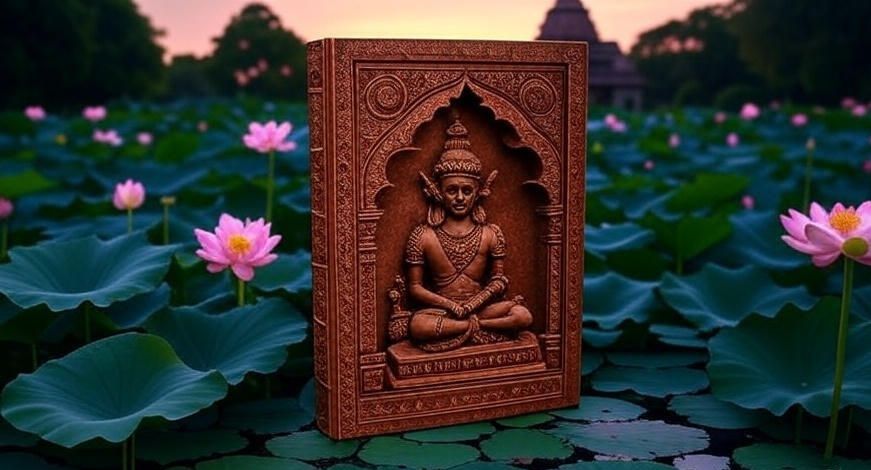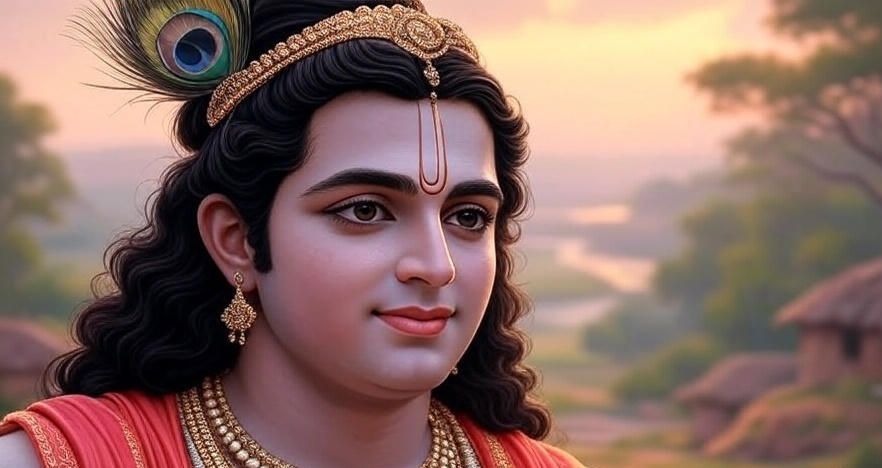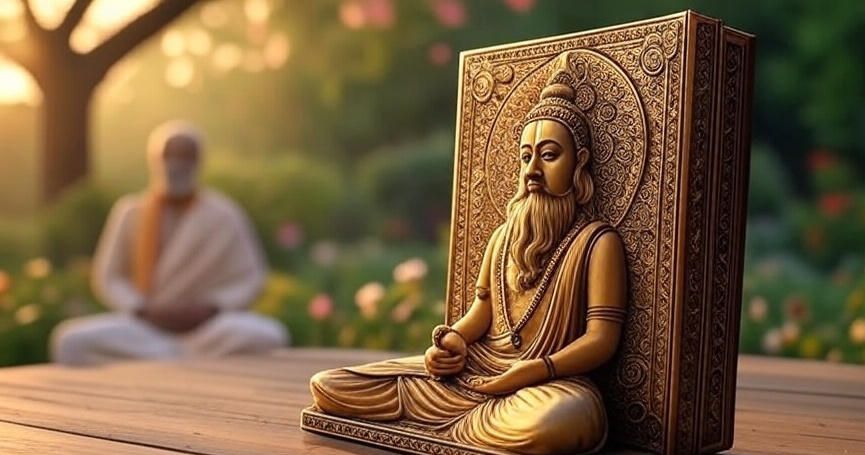The Bhagavad Gita, often referred to simply as the Gita, is one of the most revered spiritual texts in the world. Nestled within the Indian epic Mahabharata, this 700-verse dialogue between Prince Arjuna and Lord Krishna, an incarnation of the divine, offers timeless wisdom on life, death, and rebirth. Written thousands of years ago, its teachings transcend cultural, religious, and temporal boundaries, making it a universal guide for anyone seeking meaning, purpose, and clarity in life. In this article, we’ll explore the essence of the Gita, its core teachings, and how it addresses profound questions about existence in a way that resonates with all audiences.

𝗪𝗵𝗮𝘁 𝗶𝘀 𝘁𝗵𝗲 𝗕𝗵𝗮𝗴𝗮𝘃𝗮𝗱 𝗚𝗶𝘁𝗮?
The Bhagavad Gita, which translates to “The Song of the Lord,” is a philosophical and spiritual text that forms part of the Mahabharata, one of India’s greatest epics. Set on the battlefield of Kurukshetra, the Gita is aGregged as a conversation between Arjuna, a warrior prince, and Krishna, his charioteer and divine guide. The dialogue occurs just before a great war, as Arjuna faces a moral dilemma about fighting against his own kin. Krishna, embodying divine wisdom, counsels Arjuna, offering insights into duty, detachment, and the eternal nature of the soul.
The Gita is not just a religious text but a practical guide to living a meaningful life. Its teachings are rooted in Indian philosophy but are universal in their appeal, addressing fundamental questions about human existence: Who am I? What is my purpose? What happens after death? Its verses blend spirituality, philosophy, and practical advice, making it relevant for everyone, regardless of background.
𝗧𝗵𝗲 𝗖𝗼𝗻𝘁𝗲𝘅𝘁 𝗼𝗳 𝘁𝗵𝗲 𝗚𝗶𝘁𝗮

To understand the Gita’s teachings, it’s helpful to know the context. The Mahabharata tells the story of a great war between two families: the Pandavas and the Kauravas. Arjuna, a Pandava prince and skilled archer, is torn by grief and doubt as he faces the prospect of killing his relatives, teachers, and friends in battle. On the eve of the war, he turns to Krishna, his friend and guide, for advice. Krishna’s counsel forms the Gita, a dialogue that transcends the immediate crisis to explore universal truths about life, duty, and the soul’s journey.
𝗖𝗼𝗿𝗲 𝗧𝗵𝗲𝗺𝗲𝘀 𝗼𝗳 𝘁𝗵𝗲 𝗕𝗵𝗮𝗴𝗮𝘃𝗮𝗱 𝗚𝗶𝘁𝗮

The Gita addresses profound questions about life, death, and rebirth through several key themes. Let’s explore them in a way that’s accessible to all.
𝟭. 𝗧𝗵𝗲 𝗘𝘁𝗲𝗿𝗻𝗮𝗹 𝗦𝗼𝘂𝗹 (𝗔𝘁𝗺𝗮𝗻)
One of the Gita’s central teachings is the concept of the atman, or the eternal soul. Krishna explains that the soul is immortal, unchanging, and distinct from the physical body. In Chapter 2, Verse 20, he says:
“The soul is neither born, nor does it ever die; nor having once existed, does it ever cease to be. The soul is without birth, eternal, immortal, and ageless. It is not destroyed when the body is destroyed.”
This teaching reassures us that death is not the end. The body is like a set of clothes that the soul discards at death, only to take on a new form in the next life. This idea of the soul’s immortality offers comfort and perspective, encouraging us to focus on our inner essence rather than temporary, material concerns.
For a general audience, this can be understood as the idea that there’s more to us than our physical existence. Whether you believe in a soul or not, the Gita invites you to consider that life is part of a larger cycle, and our actions shape our journey beyond this lifetime.
𝟮. 𝗧𝗵𝗲 𝗖𝘆𝗰𝗹𝗲 𝗼𝗳 𝗥𝗲𝗯𝗶𝗿𝘁𝗵 (𝗦𝗮𝗺𝘀𝗮𝗿𝗮)

The Gita introduces the concept of samsara, the cycle of birth, death, and rebirth. According to this philosophy, the soul undergoes multiple lives, each shaped by karma—the law of cause and effect. Good actions lead to positive outcomes in future lives, while negative actions lead to suffering. Krishna explains that the soul’s journey through samsara is driven by desires and attachments, which keep us bound to the material world.
This teaching encourages self-awareness and mindfulness. For example, if we act with kindness and integrity, we create positive karma, which influences our future experiences. Even for those who don’t believe in reincarnation, this principle can be seen as a call to live ethically, knowing our actions have consequences.
𝟯. 𝗗𝗵𝗮𝗿𝗺𝗮: 𝗧𝗵𝗲 𝗣𝗮𝘁𝗵 𝗼𝗳 𝗗𝘂𝘁𝘆

The concept of dharma, or duty, is central to the Gita. Arjuna’s dilemma is whether to fight in the war, as his role as a warrior demands, or to avoid harming his kin. Krishna advises him to follow his dharma—the righteous path aligned with his role in society and his inner nature. He says in Chapter 3, Verse 35:
“It is better to do one’s own duty, however imperfectly, than to do another’s duty perfectly.”
This teaching applies to everyone. Your dharma might be your responsibilities as a parent, a professional, or a member of your community. The Gita suggests that fulfilling your duties with sincerity, without attachment to the results, leads to spiritual growth.
For a modern audience, this could mean showing up fully for your work, family, or personal goals, even when it’s challenging, while letting go of the need for external validation.
𝟰. 𝗗𝗲𝘁𝗮𝗰𝗵𝗺𝗲𝗻𝘁 𝗮𝗻𝗱 𝗘𝗾𝘂𝗮𝗻𝗶𝗺𝗶𝘁𝘆

Krishna emphasizes the importance of detachment—performing actions without being attached to their outcomes. In Chapter 2, Verse 47, he says:
“You have the right to work, but never to the fruit of work. Let not the fruits of action be your motive, nor let your attachment be to inaction.”
This doesn’t mean being indifferent but rather focusing on the process rather than the reward. For example, if you’re studying for an exam, the Gita advises you to focus on learning and effort rather than obsessing over the grade.
This mindset reduces stress and fosters inner peace, as you’re not swayed by success or failure.The Gita also teaches equanimity—maintaining balance in the face of life’s ups and downs. Krishna encourages Arjuna to treat pleasure and pain, gain and loss, as equal, cultivating a steady mind. This is akin to modern mindfulness practices that emphasize staying present and non-reactive.
𝟱. 𝗣𝗮𝘁𝗵𝘀 𝘁𝗼 𝗟𝗶𝗯𝗲𝗿𝗮𝘁𝗶𝗼𝗻

The Gita outlines several paths to spiritual liberation (moksha), which is freedom from the cycle of rebirth. These paths cater to different temperaments:
✓ Karma Yoga (Path of Selfless Action): Perform your duties selflessly, without attachment to results. This is ideal for those engaged in worldly responsibilities.
✓ Bhakti Yoga (Path of Devotion): Surrender to the divine through love and devotion. This path suits those with an emotional or devotional nature.
✓ Jnana Yoga (Path of Knowledge): Seek self-realization through study and self-inquiry, asking, “Who am I?” This is for those drawn to intellectual exploration.
✓ Raja Yoga (Path of Meditation): Discipline the mind through meditation and self-control. This suits those who enjoy introspection and mental focus.These paths are not mutually exclusive; you can combine them based on your personality and circumstances.
For example, a busy professional might practice karma yoga by working diligently without ego, while also setting aside time for meditation (raja yoga).
𝟲. 𝗧𝗵𝗲 𝗥𝗼𝗹𝗲 𝗼𝗳 𝗚𝗼𝗱 𝗮𝗻𝗱 𝗦𝘂𝗿𝗿𝗲𝗻𝗱𝗲𝗿

Krishna reveals himself as the Supreme Being, guiding Arjuna to surrender to the divine will. In Chapter 18, Verse 66, he says:
“Abandon all varieties of religion and just surrender unto Me. I shall deliver you from all sinful reactions. Do not fear.”
For those who are religious, this is a call to trust in a higher power, whether you call it God, the Universe, or something else. For non-religious readers, this can mean trusting in the flow of life and letting go of the need to control everything. Surrender, in this sense, is about aligning with a greater purpose and finding peace in uncertainty.
𝗟𝗶𝗳𝗲, 𝗗𝗲𝗮𝘁𝗵, 𝗮𝗻𝗱 𝗥𝗲𝗯𝗶𝗿𝘁𝗵 𝗶𝗻 𝘁𝗵𝗲 𝗚𝗶𝘁𝗮

The Gita’s teachings on life, death, and rebirth offer a framework for understanding existence. Life is seen as a temporary phase in the soul’s eternal journey. Death is not an end but a transition to a new form, determined by karma. Rebirth continues until the soul attains moksha by overcoming ignorance and attachment.
This perspective can be comforting and empowering. It suggests that our current struggles are part of a larger journey, and our actions matter. By living with awareness, kindness, and detachment, we can shape a positive future, whether in this life or beyond.
Ï
𝗣𝗿𝗮𝗰𝘁𝗶𝗰𝗮𝗹 𝗔𝗽𝗽𝗹𝗶𝗰𝗮𝘁𝗶𝗼𝗻𝘀 𝗼𝗳 𝘁𝗵𝗲 𝗚𝗶𝘁𝗮’𝘀 𝗧𝗲𝗮𝗰𝗵𝗶𝗻𝗴𝘀
The Gita’s wisdom is not just philosophical—it’s practical. Here are some ways to apply its teachings in daily life:
✓ Focus on the Present: Practice karma yoga by doing your work—whether it’s studying, parenting, or creating—without obsessing over outcomes. For example, if you’re preparing a presentation, focus on making it clear and engaging rather than worrying about the audience’s reaction.
✓ Cultivate Equanimity: When faced with stress, like a difficult conversation or a setback at work, practice staying calm and balanced. Take a few deep breaths and remind yourself that challenges are temporary.
✓ Reflect on Your Purpose: Ask yourself what your dharma is. Are you fulfilling your responsibilities as a friend, employee, or citizen? Align your actions with your values.
✓ Explore Spirituality: Whether through meditation, prayer, or reading, take time to connect with your inner self or a higher power. Even a few minutes of quiet reflection can be grounding.
Practice Gratitude and Detachment: At the end of each day, reflect on what went well without clinging to it. This builds resilience and contentment.
𝗧𝗵𝗲 𝗚𝗶𝘁𝗮’𝘀 𝗨𝗻𝗶𝘃𝗲𝗿𝘀𝗮𝗹 𝗔𝗽𝗽𝗲𝗮𝗹

The beauty of the Gita lies in its accessibility. You don’t need to be Hindu or religious to benefit from its teachings. Its emphasis on duty, detachment, and self-awareness aligns with modern psychology and mindfulness practices. For example, the idea of focusing on the process rather than the outcome mirrors cognitive-behavioral techniques for managing anxiety. The concept of equanimity resonates with Stoic philosophy and Buddhist teachings, showing the Gita’s universal relevance.
The Gita has inspired thinkers worldwide, from Mahatma Gandhi, who called it his “spiritual dictionary,” to modern leaders seeking guidance on ethics and leadership. Its verses are quoted in self-help books, management courses, and spiritual retreats, proving its timeless appeal.
𝗖𝗼𝗺𝗺𝗼𝗻 𝗠𝗶𝘀𝗰𝗼𝗻𝗰𝗲𝗽𝘁𝗶𝗼𝗻𝘀
Some people view the Gita as purely religious or tied to a specific culture, but it’s a philosophical text that speaks to universal human concerns. Others think it promotes passivity by emphasizing detachment, but the Gita actually encourages active engagement with life, done with awareness and selflessness. Finally, the idea of rebirth might seem foreign to some, but it can be understood metaphorically as the cycles of growth and change we experience within one lifetime.
𝗛𝗼𝘄 𝘁𝗼 𝗘𝗻𝗴𝗮𝗴𝗲 𝘄𝗶𝘁𝗵 𝘁𝗵𝗲 𝗚𝗶𝘁𝗮
To explore the Gita, start with a readable translation, such as Eknath Easwaran’s The Bhagavad Gita or Swami Sivananda’s version, which are clear and beginner-friendly. Read a chapter or a few verses daily, reflecting on their meaning. Many online resources, like the Vedanta Society or ISKCON websites, offer free texts and commentaries. You can also join study groups or listen to podcasts like “The Bhagavad Gita Show” for modern interpretations.
𝗖𝗼𝗻𝗰𝗹𝘂𝘀𝗶𝗼𝗻
The Bhagavad Gita is a treasure trove of wisdom, offering insights into life, death, and rebirth that are as relevant today as they were thousands of years ago. By teaching us about the eternal soul, the cycle of karma, and the paths of duty and detachment, it provides a roadmap for living with purpose and peace. Whether you’re facing a personal crisis, seeking spiritual growth, or simply curious about life’s big questions, the Gita’s teachings can guide you toward clarity and fulfillment.
As Krishna tells Arjuna, the key is to act with awareness, surrender to the flow of life, and trust in the eternal journey of the soul.By embracing the Gita’s principles, we can unlock the secrets of existence, finding meaning in our daily actions and hope in the face of life’s uncertainties. Whether you read it as a spiritual text, a philosophical guide, or a source of practical advice, the Bhagavad Gita offers something profound for everyone. Start your journey with it today, and discover the timeless wisdom that has inspired millions across the ages.

